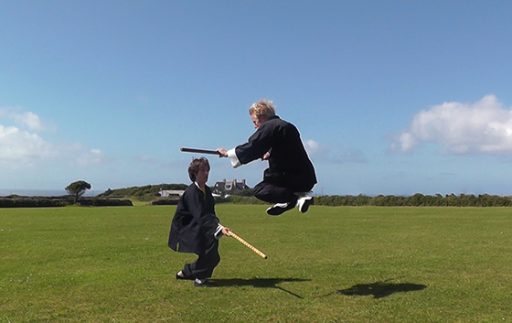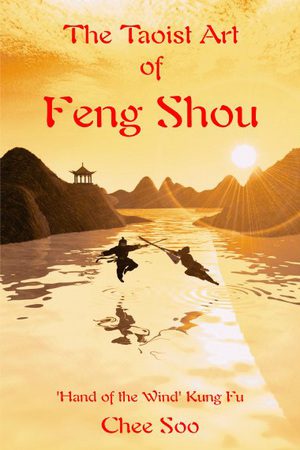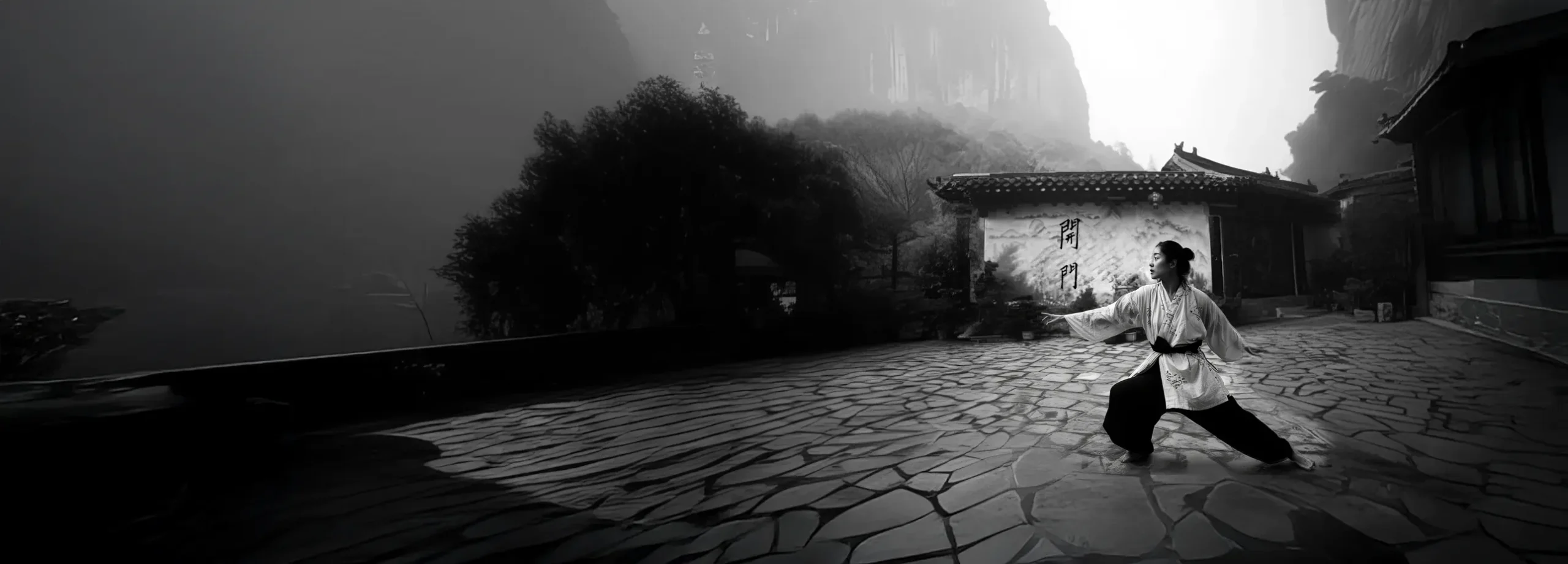
No one can say exactly when the Chinese arts of self-defence first came into being, but the seeds go back to the very early days of the primitive period, when man first roamed the earth. Before he had even invented a weapon, man had to protect himself with his bare hands against the attacks of his fellow countrymen as well as the wild animals.
So this man and beast situation existed throughout the primitive world: sooner or later it had to come to be that one or the other species had to assert its overall mastery and supremacy, and it was then that the Chinese really excelled, and laid down the foundations for all humanity to follow. Once they had learnt to master themselves, and anything that threatened their existence, and learnt to organize their family groups, they went on to build the earliest civilizations in that period. The techniques and the knowledge that they used eventually spread way beyond their boundaries and shores, and helped many other people and races in far-off territories.
Not only did the Chinese excel in all aspects of silk weaving, gunpowder making, painting, building wells and irrigation systems, herbal therapy, and all the other dynamic health arts including Ch’ang Ming, through the great wisdom and knowledge brought to them by the ‘Sons of Reflected Light’, but they were the first nation to put martial arts on a scientific basis. This was because not only did they explore every avenue of physical dexterity and manipulation, but they also used the natural dynamic vitality power of the body (Sheng Ch’i) and the enormous macro-cosmic power of the universe (Ching Sheng Li), and these are still being used by the Chinese through the Taoist Arts, and in Feng Shou which is our particular style of kung fu.
Kung fu 功夫, means ‘working man’ or ‘man of the fist’ depending on the way it is written in Chinese, and we shall devote ourselves to this, and to the understanding of its origins.
We know that the fighting styles used by many Oriental countries, including the Japanese Karate and the Korean art of Tae Kwan Do, are adaptions and imitations of the basic forms of various styles of kung fu, taught to the local inhabitants by Chinese immigrants, and which were eventually adapted to suit the needs and attitudes of these lands.
Some of the various styles that have evolved have changed to such a degree that in many cases they no longer bear the slightest resemblance to the original foundation given by the Chinese, and so it is not surprising that many followers of these newer arts try to forget that they owe their skills to the early Chinese, and overlook the close links that these arts once had. Within China the original kung fu foundations were laid down in the primitive period, as we have already mentioned, but the actual records of the arts only go back some 5,000 years.
One of the main reasons why there is so little information available on the early days of the martial arts, is because none of the early masters or their pupils kept precise written records of their training programmes or the techniques that they practised. This was due, no doubt, to the fact that this information was not intended for the general public, but only for those pupils who proved themselves worthy of the techniques, skills and the tradition of that particular school or style. So, generally, these were closely-guarded secrets, and were handed down from father to son, master to pupil, and generation to generation.
When the student also became a master, in his own right, he too would only pass on his skills and knowledge to those he thought would not only be worthy of them, but who would also treasure them as he had done over many, many years. In fact, the knowledge of the art of ‘Feng Shou’ goes back at least 2,000 years, and has been handed down through the Lee family for all this time, and has been passed to us by our late master, Chan Kam Lee. Add the modesty and the humility that are impressed upon every Chinese child, and the philosophy that is inbred in his daily life, and you can perhaps understand why so few records were ever kept.
Yet despite this, we know that a brilliant doctor called Hua Tuo 華佗 formulated a series of movements coupled with special breathing exercises that were intended to limber up the body, ease the nerves, and generally reduce bodily tensions. We also know that the Taoists formulated many specialized stances and exercises together with many precise breathing formulas in K’ai Men (the Open Door) which is the Taoist Yoga, and in T’ai Chi Ch’uan (the Supreme Ultimate) in their long search for physical alchemy.
All these have been so successful that they are still in use today, although over the centuries certain modifications have quite naturally taken place. Many of the breathing exercises are practised in the Chinese Health Arts of Pa Chin Hsien (Eight Strands of the Brocade) where they help to effect many cures for a large variety of ailments and sickness. They are also the basic foundation for the development, cultivation, activation, of the Internal Energy (Sheng Ch’i) and the External Energy (Ching Sheng Li).
According to tradition, after the Taoists and Hua Tuo laid down the early foundations, there came a Buddhist monk called Bodhiharma, who, in 500 AD left his Brahman tribe in southern India and crossed the Himalayas into China. After a long, slow and laborious journey across extremely rugged terrain, he eventually arrived at Chien K’ang, which was then the capital of the Liang province.
It was well known that the Emperor Wu was a Buddhist with an enthusiastic interest in all Buddhist doctrines. On learning this, Bodhiharma immediately sought an audience with the Emperor, and as a result the monk was given permission to teach and preach in the province.
So Bodhiharma began spreading the word and the doctrine of Ch’an, which the Japanese later adapted and called Zen. However, at that time it was found that these teachings not only clashed with the beliefs and the philosophy of the Chinese, but they were also found to be so complex that everyone, including the Emperor, found it extremely difficult to grasp even the fundamentals. This therefore created a tremendous amount of friction, frustration, irritation, and eventually such bad feeling towards Bodhiharma that he was dismissed from the Emperor’s service.
It was then that he decided to travel northwards, although nobody knows why he decided to take that particularly difficult direction. The roads were extremely bad and in some cases almost non-existent, and he spoke very little Chinese so there was also a language problem, made worse by the fact that there would have been many different dialects spoken on this long journey. A greater hazard was the many roaming armed bands of thieves and robbers in the countryside along his chosen route. Small wonder then that it took him more than three years to cross the Yangtse River, and reach his intended destination of the Shaolin Temple at Sung Shan in Henan province.
He stayed at the Shaolin Temple for nearly ten years, teaching and meditating, and it was during the latter part of his stay that he realized that many of his pupils were not fit enough, either mentally or physically, to endure the physical austerity imposed by his teachings.
Ch’an Buddhism was based on very deep meditation with its aims being the unification of mind, body and spirit, and therefore Bodhiharma felt that physical endurance would help to equip his pupils for this objective. He borrowed a number of the Taoist stances and exercises, and hardened them up to create within the practitioners a sense of internal strength, and a feeling of inseparability of mind and spirit within the body. Thus he encouraged literally throwing yourself within yourself, becoming one single entity with all three parts becoming one, and so achieving constant harmony in the daily toil of life.
Many of these exercises would not be classed as entirely physical by today’s standards, especially as the feet made no movement at all; even so, they soon earned the Shaolin monks the reputation of being China’s toughest and the most formidable unarmed fighters.
Strangely enough, though, despite the monastery’s nationwide reputation, Bodhiharma’s pupils gradually dwindled away. This may have been due to the complexity and the severity of his teachings. However, part of his work and the foundation that he laid down still lived on, and to those basic exercises and movements, others were gradually added and further techniques evolved and so kung fu in its earliest form came into being.
It has been established that Bodhiharma did actually exist during this period, but how much he actually contributed to the art of kung fu, as we know it today, will always remain a controversial subject. But there is no doubt whatsoever, that he did lay the foundation on which are built many of the hard styles and solid defensive systems of the art of the Chinese boxing art of kung fu.
Another very significant period in the history of this art was the Sung Dynasty (960-1279) which brought about a radical change in Chinese thinking which gradually affected not only kung fu but all the arts. Until this time, the techniques were carried out from very stiff and static stances, in an endeavour to harden and toughen the body which in those days was considered essential to any martial art practitioner, together with synchronized movements and the use of sheer brute muscular strength. Indeed, many martial art schools still teach this style, and the Japanese Karate is based on these same principles.
But the really important change came about when stiffness was replaced by pliability, static techniques were overcome with speed and dexterity, and internal or intrinsic energy took the place of physical and muscular strength.
From this time onwards, the Chinese arts made fantastic progress, and the technical advancement was so progressive that even the old masters of the arts were amazed. Since those early days many famous Chinese have made their mark on the martial arts by adding techniques, new adaptations, new systems of exercising and training, new forms and sets of movements, and have, in some cases, made improvements on the old techniques.
By reducing the necessity of using muscular strength, the arts then became available even to the very young and the very old alike, and girls and women could now participate as well.
To this day there are many Chinese schools and hospitals who use the classic sets of movements (especially T’ai Chi Ch’uan), as a form of physical therapy. But it is not limited to this alone, for in modern China it is a common sight to see groups of people, men and women, getting together during the factory or office lunch break and performing some of these sets, simply to control the mind, to keep the body fit, and to attain internal peace and tranquillity.
China is a massive country and, like all countries, in the old days the communications were very poor, and just as dialects occurred in the national language, so did variations and differences appear in the styles of kung fu.
Furthermore, those Chinese who emigrated in the past to other countries took their own particular style of kung fu with them, and its evolution was largely independent of Chinese thought. So in places like Hong Kong, Malaya, Hawaii, California, and other areas where there are large gatherings of Chinese, there are a number of schools, each with its own methods and systems of training.
The main difference that stamps a particular style is the use of the hands and their adaptions and, to a lesser degree, the use of the feet — except in the very northern schools where the feet are used to a far greater extent.
The environment has played the most important part in the establishment of styles, and even to some extent the various techniques that were used. In the south where there were large open spaces of paddy fields, swamps and jungle bogs, and where large fishing fleets sailed around the coast, then hand techniques had to be used more because the legs were either soaked in mud and water up to the knees, or the feet were necessary to retain good balance whilst on board a boat rocking on the high seas. In the mountains of the north, the ground was hard, thus allowing greater flexibility in the use of the foot and leg techniques.
There are still many styles existing in the world today, and these are normally defined under certain categories, such as the ‘soft’ style (Juan Shou), ‘hard fist’ style (Ying Ch’uan), ‘short’ style (Tuan), ‘long’ style (Ch’ang), ‘hand art’ (Shou Shu) and the ‘foot art’ (Jiao Shu).
The Feng Shou (pronounced in Mandarin as Fung Show) style of kung fu that we practise in the International Wu Shu Association consists of a complete mixture of all the above categories, because the style emanated from Central China, and therefore had the advantage of using the best from both the southern and northern styles, so it has everything in it, together with its own unique dynamic style. It is basically a ‘soft’ style, which means that we use speed, skill, wonderful balance, and we build up our Inner Power to such an advanced degree that we have no need whatsoever to use our physical or muscular strength. We are the softest and fastest style in existence.
In the Chinese arts we will never say that one style is better than another because all Chinese admire one another and will do all they can to help and assist each other whenever required. However, it must be understood that if you rely on pure physical strength, then you can be defeated by a much stronger opponent, providing, of course, the standard of skill is equal. In the soft arts we do not use physical strength so we do not have to rely upon it, and therefore it is skill that counts, plus the use of internal power which has to be developed to such a degree that it will be far superior to any form of physical strength anyway.
Whilst many of the styles today emanated from the earliest teachings of Ch’an Buddhism at the Shaolin Temple, our particular style of Feng Shou goes back much earlier in time, in fact, to the very early formation of exercising by the Taoists, and our Taoism unites all of us in the International Wu Shu Association in our aims, ideals, and our physical path together with our spiritual growth.
We are one within the Taoists arts, and we are one with our Maker.

From
The Taoist Art of Feng Shou
by Chee Soo
